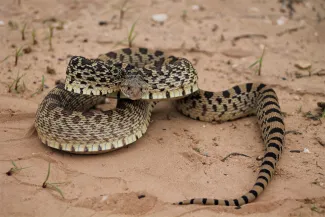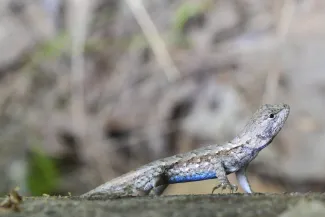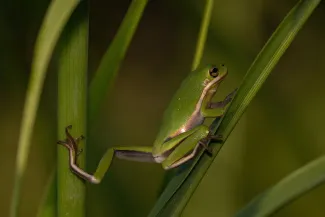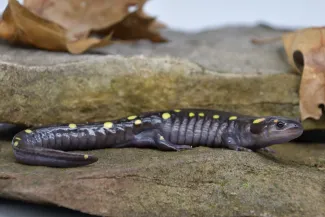Oklahoma is often thought of as an ecological melting pot, where forests, prairies, and wetlands meet to provide habitat for a truly impressive list of animals. That blend of eastern and western species – including those rare and common, secretive and showy – undoubtedly holds true for Oklahoma’s reptiles and amphibians.
Collectively known as herpetofauna, or simply “herps,” 140 species of salamanders, frogs, turtles, lizards, snakes, and alligator have been documented in the Sooner State. Reptiles and amphibians can be found across the entire state, including the 100 or so wildlife management areas owned or operated by the Oklahoma Department of Wildlife Conservation.
While Oklahoma’s reptiles and amphibians aren’t traditionally thought of as “hunted” species, the catching, keeping or even the holding of salamanders, frogs, turtles, lizards, and snakes requires, by law, a hunting or fishing license. The specific license depends on where the animal is pursued: A hunting license is required for land-dwelling animals, and a fishing license is needed for water-dwelling animals. Youths 17 and younger, and resident landowners or tenants who hunt or trap only on land owned or agriculturally leased to them are exempt from these statewide licenses. Specific license requirements, reptile and amphibian bag limits, and closed seasons may be found in the Oklahoma Hunting and Fishing Regulations.
Meet Oklahoma's Reptiles and Amphibians

Spiny Softshell Turtle
Resident at Hal and Fern Cooper WMA
Softshell turtles may be comically flat as a pancake but their ability to run and swim is no joke! Two species may be found in Oklahoma, with the spiny softshell associated with sandy rivers, streams, and ponds or lakes statewide. Distinguishing between the spiny and smooth softshells is relatively easy where their ranges overlap but getting close enough to look for the spiny softshell’s patterned front legs, spines on the leading edge of the shell, and projections in the nostril can be a real challenge. Both species are closely tied to water and may spend time buried in the sand with only their nostrils “periscoping” above the water.
The Beaver River meets Wolf Creek in the 16,120-acre Hal and Fern Cooper WMA, creating the North Canadian River and a welcome refuge for turtles and other wetland reptiles and amphibians amid the sandy prairie. Further upland, snakes, lizards, and more arid-adapted species thrive.

Bullsnake
Resident at Hackberry Flat WMA
Measuring up to 6 feet long, the bullsnake is one of Oklahoma’s longest snakes, and has a personality to match! If encountered, they may be of a docile nature or take a more defensive stance by holding a coiled pose, vibrating its tail, or letting out a loud hiss. These stunning snakes have a beige background with dark brown blotches running across the body and a banded tail. Bullsnakes may be found in woodlands and prairies in the western two-thirds of Oklahoma. They primarily eat rodents and often hunt in and around their burrows.
Hackberry Flat WMA may be best known for its bird hunting opportunities, but this 7,566-acre managed wetland in southwestern Oklahoma is no stranger to reptiles and amphibians. Beyond upland species like the bullsnake, several frogs, snakes, and turtles may be active in the wetland units, especially after rains.

Prairie Lizard
Resident at Lexington WMA
Outside of a quick glimpse and slight skittering sound as it scrambles across leaves and rocks, the 4-7-inch prairie lizard may go unnoticed much of its active season. But males develop glinting blue and green on the jaws, throats, and chest during the breeding season, and may even impress careful observers with a series of push-ups! These lizards are found statewide and may be found sunning in woodlands, prairies, and rocky outcrops.
The 9,512-acre Lexington WMA is located within an hour of the Oklahoma City Metro, offering an easy access point for nature experiences. The area’s mix of hardwood forests, open prairies, and scattered ponds is a great starting point for exploring and learning more about the state’s reptiles and amphibians.

Green Treefrog
Resident at Red Slough WMA
In parts of eastern Oklahoma, a vivid green amphibian may be found blending in with the surrounding wetland vegetation. The brightly colored green treefrog has a distinctive white stripe running down each side of the body, tiny yellow flecks sprinkled across the back, and enlarged toepads that help it cling to a variety of surfaces. The male’s resonating breeding calls can be heard in late spring and summer nights near permanent water, where females deposit up to 2,500 eggs in floating packets. These frogs are most active at night and may even be drawn to house lights that attract a feast of insects.
Red Slough WMA, located in the extreme southeastern corner of the state, is a 5,814-acre haunt for treefrogs and other reptiles and amphibians. Cooperatively managed by the Oklahoma Ranger District of the Ouachita National Forest, the Natural Resources Conservation Service and the Wildlife Department, this restored area is thought to be one of the most biologically diverse Wetland Reserve Projects in the nation.

Spotted Salamander
Resident at Cookson WMA
With two rows of bright yellow and orangish spots, the spotted salamander certainly lives up to its name! This relatively large amphibian lives in moist, forested areas and can be found in two large pockets of eastern Oklahoma. They thrive underground for much of the year but emerge in early spring and migrate to breeding ponds where females lay egg masses that may hold up to 300 eggs. Outside of this migration, spotted salamanders are primarily found under logs and rocks.
Cookson WMA is a 15,280-acre herp hotspot located in Adair and Cherokee counties in northeastern Oklahoma. In addition to other reptiles and amphibians, about 40% of the state’s salamander species have been documented on the area.